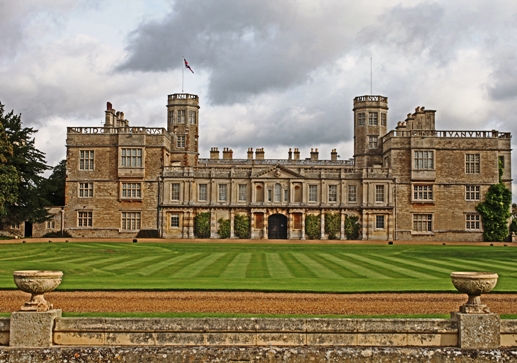 Spencer Compton was a fossilist, Marquess and noted correspondent. Philip Compton* reports on a significant but overlooked figure.
Spencer Compton was a fossilist, Marquess and noted correspondent. Philip Compton* reports on a significant but overlooked figure.
Spencer Compton (1790-1851) collected fossils. And in later life, after the death of his father in 1828, he inherited the title ‘Marquess of Northampton’ and the impressive estates and wealth that came with it. He acted successfully as President of many important organisations; the Geological Society (1820-22), the Royal Society (1838-48), the Royal Archaeological Institute (1845-51), the Royal Society of Literature (1849-51), and as Trustee of the British Museum (1849-51). And yet his name and reputation have been almost entirely eclipsed with the passage of time.
Picture: Castle Ashby, where Spencer Compton entertained many eminent geologists of the early 19th Century.
As a landed aristocrat, he might have been expected to be a patron of the arts and sciences. And indeed, he did subscribe to various publications, thus contributing towards scientific causes. But this image alone does hardly does justice to Compton’s depth of scientific knowledge, which is visible now only when reflected in the letters written to him by his colleagues in the Geological Society.
His role was twofold; firstly he was a knowledgeable friend to the geologists, and secondly he mediated between academics and politicians, using his connections to further the cause of science and promote the establishment of geological collections in public museums.
COLLECTIONS
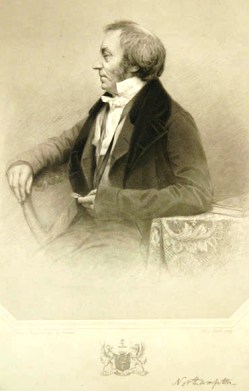 Picture: Spencer Joshua Alwyne Compton, 2nd Marquess of Northampton
Picture: Spencer Joshua Alwyne Compton, 2nd Marquess of Northampton
Compton was actively involved in the purchase, by the British Museum (BM), of three major collections; those of Proby Cautley, Thomas Hawkins, and Gideon Mantell. In January 1838, when Mantell was in financial trouble, he asked Compton to communicate with the Chancellor of the Exchequer, Thomas Spring Rice, about the sale of his geological collection, which he duly did. In July 1838 Mantell requests Compton to be one of the five valuers of his collection, alongside Buckland, Kӧnig and Stutchbury (at the BM).
One year later, in 1839, William Buckland requests Compton to push Spring Rice to provide funding for the purchase of Hawkins’ collection:
“… if your Lordship would have opportunity of stating to Mr Spring Rice your opinion of the value and importance of the collection in question, founded on your own personal examination and on the opinions expressed by the highest of all authorities upon such a subject Mr Owen”
Hawkins’ collections were controversial because in 1834 he sold to the BM almost perfect fossilised skeletons which he had laboriously completed by replicating missing bones, duping the two valuers (Buckland and Mantell), who persuaded the trustees to buy the initial collection for £1,250. Describing a fossil-collecting trip to Dorset in 1832, Mantell prophetically writes to Compton of Hawkins:
“Mary Anning had nothing of interest remaining except a fine group of Pentacrinites which was reserved for Mr Hawkins, the young Impon, whose fine specimens of Ichthyosauri have been the admiration of the London academs, and will I fear be the ruin of him.”
ANNING
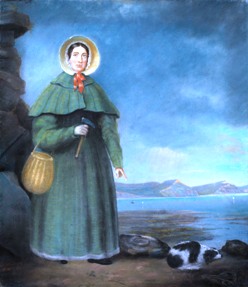 Picture: Mary Anning
Picture: Mary Anning
It is well known that Mary Anning’s gender and social status prevented her from achieving public recognition for her collecting and fossil-identification prowess; but Buckland’s view of her practical skills becomes evident in a letter to Compton, where he simultaneously extols the virtues of Hawkins’s collection:
“With respect to Mr Hawkins 2nd collection your Lordship seems to imagine that it is chiefly from Lyme [Regis]. This is not so the specimens at least all the best, are from Street near Glastonbury near the residence of Mr Hawkins. And they are not like those at Lyme in shale which splits and readily exposes its bones, but they are embedded in lias as hard as marble and sometimes harder, from which nothing but the unique skill and enthusiasm and anatomical knowledge of Mr Hawkins could ever extricate them, so that if those quarries were full of them they can never be seen again so good. The slates from which Hawkins carves them out wld be worthless in the hands of Mary Anning.”
Compton, as friend of Mantell, Cautley and Buckland, played a pivotal but discreet role by persuading the Chancellor of the Exchequer to negotiate around the purchase of these collections, which are now housed in the Natural History Museum. Having been MP for Northampton 1812-20, he was well acquainted with many political figures, and corresponded with no fewer than four Chancellors of the Exchequer; Henry Goulburn, Thomas Spring Rice, John Spencer (Viscount Althorp) and Robert Peel.
The nature of the relationships he maintained with academics can be better understood by an analysis of the vast number of correspondences between Compton and geologists at the pinnacles of their careers. The list is impressive; Whewell, Sedgwick, Owen, Murchison, Mantell, Lyell, Horner, Herschel, de la Beche, Conybeare, Cuvier and Brewster all wrote to the Marquess. There are 34 surviving letters from Buckland to Compton. Clearly he was deeply entrenched in academic circles, especially geological ones.
BUCKLAND
In a letter from July 1832, Buckland enquires about a pocket microscope he gave to Compton, to help with his fossil analysis. In another letter, dated 10 May 1835, it emerges that Compton is godfather to one of Buckland’s children: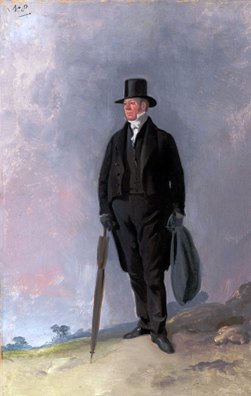 “I will bring your unanswered letter in my pocket, and can now only plead in excuse that I was intensely busy and also unwell at the time of its arrival and afraid to venture on the voluminous reply which the number of your queries seemed to require. We have recently been overwhelmed with most severe afflictions by the loss of our 2 youngest children within 2 days, and each after a few hours illness by Hooping <sic> Cough. Your little God daughter was first taken from us, and expired in perfect tranquillity having suffered no pain during the whole of her short illness. The little boy a year older was taken off next day in violent and dreadful convulsions.”
“I will bring your unanswered letter in my pocket, and can now only plead in excuse that I was intensely busy and also unwell at the time of its arrival and afraid to venture on the voluminous reply which the number of your queries seemed to require. We have recently been overwhelmed with most severe afflictions by the loss of our 2 youngest children within 2 days, and each after a few hours illness by Hooping <sic> Cough. Your little God daughter was first taken from us, and expired in perfect tranquillity having suffered no pain during the whole of her short illness. The little boy a year older was taken off next day in violent and dreadful convulsions.”
Picture: William Buckland
This emotionally charged passage merges with the subject of his recent study:
“This family calamity has interfered materially with the progress of my Bridgewater Essay […] the great mass of my engravings are however finished, and some of them are very pretty especially those illustrating the mechanism of the nautilus and ammonite and the cognate families – I think I have entirely made out their mode of operation by the action of the syphuncle – I have also demonstrated proof that the Belemnite was inclosed within the body of a sepia”
Buckland obviously conferred information of a complex nature to someone who must have well understood the information being expressed. It also demonstrates his use of ‘functional morphology’, as it has come to be known, when interpreting fossil data. In the same letter:
“I took the liberty of assuring Mr Agassiz at Edinburgh that he might venture to calculate on your Lordship as a subscriber to his admirable work on fossil fishes. He forms a continuation of Cuvier’s frogs into another class of fossil animals.”
That Buckland supposed Compton would provide support to Agassiz is evidence of a deep mutual understanding of their respective scientific opinions. In other correspondence (August 1835), Buckland refers to borrowed fossils used by Agassiz in his ichthyological studies:
“I am very much obliged by your lordships prompt and satisfactory reply to my queries relating to polythalamous shells which have arrived in Seaford for quotation by me […] I expect to see Agassiz tomorrow and will enquire about your box of fishes.”
The exchange of specimens went both ways, Buckland and Compton lending, borrowing, and giving each other boxes of fossils on a fairly regular basis. On 16 August 1831 Buckland wrote:
“My Dear Lord, in this box you will find a few specimens which I promised to send you and also some shells from Mrs Buckland which I trust will arrive safe – they must be unpacked most carefully or they will perish. Your little shell turns out to be a lingula. Sowerby has made a drawing of your Hamite from Earl Stoke – it is a new species. […] I am expecting here Friday and Saturday – Mr Wallich, Captn King and Mr R Brown [two botanists and the explorer captain King] and shd be very glad to get their opinion upon the beautifully white flat specimen of stratified wood in your Lordships Collection”
MANTELL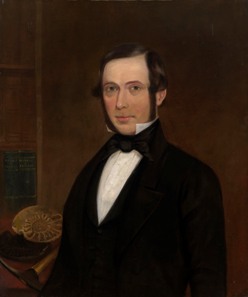
Buckland was calling upon the advice of botanists and palaeobotanists in order to help interpret Compton’s specimens of fossil flora. Seeking the advice of an expert on contemporary plant and animal life, in order to help understand and categorise fossil specimens, was common practice. Sadly, the geological content of Buckland’s letters begins to diminish after 1840, reflecting Buckland’s disillusionment with geology after his failure to propagate Agassiz’ glaciation theory, which had been widely dismissed in geological circles in favour of the ‘iceberg theory’.
The physician and palaeontologist Gideon Mantell (pictured, left) was also one of Compton’s close friends. In a letter dated July 21 1832, he vividly displays the ecstasy he felt while collecting:
“But Portland is the most interesting spot to the geologist: Zobeide’s surprise on visiting the Petrified City in Arabian Story could scarcely exceed mine (prepared as I was by Webster’s paper) on seeing the forest turned into stone and lying scattered on the vegetable mould in which the plants grow; and this lying beneath many feet of limestone the ancient soil in which the Cycadeoidea flourished even now is a better mould than that in which the potatoes of the Island are growing.
Picture: Undated letter from William Buckland to Spencer Compton.
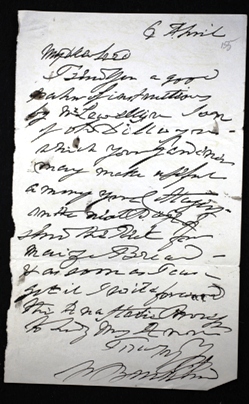
“Your lordship will I am sure be gratified to learn that since my return from Oxford I have made a grand discovery in Tilgate Forest, in spite of the poachers. A large slab of grit was blown to pieces by the workmen, perceiving many portions of bones (but fortunately none that they thought were worth preserving) they wrote to me in the hope of getting something from me which they despaired of getting from Mr Trotter [the quarry manager]. I drove over, and although the fragments were numerous and the gunpowder had stained them most horribly, and the few portions of bone that were visible looked most unpromising, yet I selected some and sent them home; after many hours exercise of patience I fitted some together, and ultimately (after three journeys to the quarry in search of fresh fragments) succeeded in making up a slab 4½ feet by 2½, containing six or eight vertebra <sic> in connection, some of the ribs attached, and the greater part of the pelvis, with portions of other bones scattered about the rest of the stone. I have been working on this stone many nights (for it is harder than granite) and with such success, that when finished, the specimen will be the finest the South of England has produced. I hope it is a young Iguanodon, but cannot yet tell. I have also a stone with four metacarpal bones in it! In the large mass we found many bones that supported the scales (dermal bones); the animal seems to have sunk down in a mass of vegetables numerous traces of ferns surround it.”
This letter presents a first-hand description of Mantell’s second great discovery, a critical moment in the history of geology. What he thought were ribs turned out in fact to be armour plating. The fossil, distinct from Iguanodon and Megalosaurus, was later named Hylaeosaurus, as it was found among tree ferns.
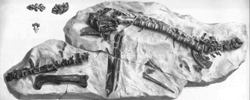 Picture: Richard OWEN, lithograph of the skeleton 'of a young Iguanodon', actually Hypsilophodon from the Isle of Wight, 1854. From a drawing by Joseph Dinkel from a specimen in James Scott Bowerbank's collection.
Picture: Richard OWEN, lithograph of the skeleton 'of a young Iguanodon', actually Hypsilophodon from the Isle of Wight, 1854. From a drawing by Joseph Dinkel from a specimen in James Scott Bowerbank's collection.
Mantell’s regard for Compton, as an academic mind, is made visible in another correspondence, dated 30 August 1845:
“My Lord, being very desirous of the favour of your Lordship’s opinion on the theory, which […] I have ventured to offer in explanation of the silicification of organic structures, and of the deposition of flint, I took the liberty a short time since, of leaving for your Lordship […] a copy of my “notes of a microscopical examination of chalk and flint””.
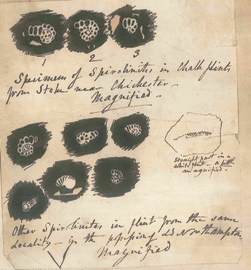 Picture: Spencer Compton, 2nd Marquess of Northampton, ink drawings of foraminifera from flint found in Sussex, 1838.
Picture: Spencer Compton, 2nd Marquess of Northampton, ink drawings of foraminifera from flint found in Sussex, 1838.
Requesting in this way Spencer Compton’s opinion on such an arcane matter as the silification of organic structures, displays the high regard in which Mantell held his geological understanding. Mantell later named a spirolinite and a dinosaur (Regnosaurus Northamptoni) after his friend.
In the many correspondences to Compton from emergent geologists, one finds little talk of profound scientific theory. Perhaps this reflects the ‘facts first’ policy of the ear;ly Geological Society. Perhaps too such elevated ideas were best kept for more informal occasions, such as at the Geological Society Club dinners, or at evening socials (soirées).
RETURN
The three decades between 1820 and 1850 form the cultural and intellectual milieu in which Darwin’s ‘natural selection’ theory emerged, finally being published in 1859. Those early geologists faced the problem of conceptually reconciling the physical evidence of creatures which existed a long time ago with the accepted biblical notion of the creation of beings, human or otherwise.
Microscope technology was improving rapidly, and small microscopes were becoming more widely available. Likewise, improving telescope technology had a similar effect. Both challenged traditional concepts of space at the same time as fossilised creatures, emerging from gravel and chalk pits, were challenging traditional notions of time. Their existence conflicted with Creationist understanding, in which - according to the Book of Genesis - the world was created in six days. The possibility of ‘pre-human’ creation was daunting, challenging; while progressivist explanations of emerging evidence conflicted with the conventional, static view of nature.
Because Spencer Compton published in geological journals on only three occasions, he is not readily portrayed as ‘a geologist’. His first two publications appeared in the Transactions of the Geological Society: one an ethnolinguistic/geological report on rock formations on the coast of Mull in 1821, the other a letter to Buckland on his own finds in Sicily in 1827.
Compton’s final paper appeared in 1838: an abstract on spirolinites in the Proceedings of the Geological Society, the full article having been rejected by Stokes. Mantell was less cautious, acknowledging Compton’s help in his chapter on spirolinites in his ‘Wonders of Geology’. Compton was an extremely cautious writer, conspicuously avoiding profound theory, leaving interpretation of his finds to others. Even when he tentatively ascribed names of newly discovered spirolinites after Buckland, Lyell, Mantell and Stokes, he added the proviso that the distinctions characterising the species may turn out to be insufficient.
FAMILY ARCHIVE
Buried in the Compton family archives is a draft speech by Spencer Compton, entitled ‘The fool has said in his heart ‘there is no God’’. It says it is intended for a Christian congregation, and in it Compton places himself in the mind of an atheist, trying to conceive of chance as the formative factor in the origins of vegetal and animal species, rather than a divine creator. Even given the breadth of his academic and intellectual acquaintance, the daring content of this speech is surprising. However it seems unlikely, given the reluctance Compton exhibits in his papers to embrace or reject any theoretical explanations, that the speech was ever given. And in fact the reason for this may lie in his high position in society.
Compton tended through life to take a somewhat neutral role in everything, avoiding controversy wherever possible. This made him a popular choice to preside over intellectual and political matters, but it conversely prevented him from expounding his own ideas. And it is is here, I believe, that we find the reason for his scientific eclipse. His drive, to further the cause of science through his own position in society, has led his name to slip from the sight of academic historians of science, despite living through a time when new geological theories were profoundly affecting the way the science of geology subsequently developed. We see him today almost entirely through the looking glass of his surviving correspondence.
Acknowledgement
I should like to thank the current Marquess of Northampton (whose name is also Spencer Compton!) for allowing me the use of his private archives. He has sponsored my research.
* Philip Compton is archive researcher for the Marquess of Northampton